The Rumor Mill: Media Outlets Reporting on Rumors as Facts Have Led to Major Consequences
Written By Colin Dooley
Reporting on rumors is something that is common practice within the journalism field. However, things can go bad quickly when media personalities and/or journalists report on these rumors as facts. One of the most recent cases came back in February 2025 when an online rumor went viral about Ole Miss student Mary Kate Cornett. This rumor about Mary Kate allegedly sleeping with her boyfriends dad, took off when Barstool Sports personalities picked up on this “story” and had posts from multiple people from within the media company offer their thoughts on it. Of course all of these takes on this alleged story were negative in nature towards Mary Kate. What also helped blow the story up was when popular ESPN personality Pat McAfee talked about it on his show, which just continued to add eyes to the viscous online rumor. Unsurprisingly, this rumor about Mary Kate turned out to be false, but the damage had already been done. As she stated in an interview with NBC, the rumor has “ruined her life”. The spread of the rumor caused her and her family, as well as her boyfriend and his family enormous amount of harassment caused by the spread from major media outlets. After it came out that this rumor was false, and a lawsuit filed by the Cornett family, Barstool founder and CEO Dave Portnoy came out and publicly apologized to Mary Kate and her family on behalf of his company. McAfee would follow suit and also issue an apology for his role in fanning the flames of the rumor about her.
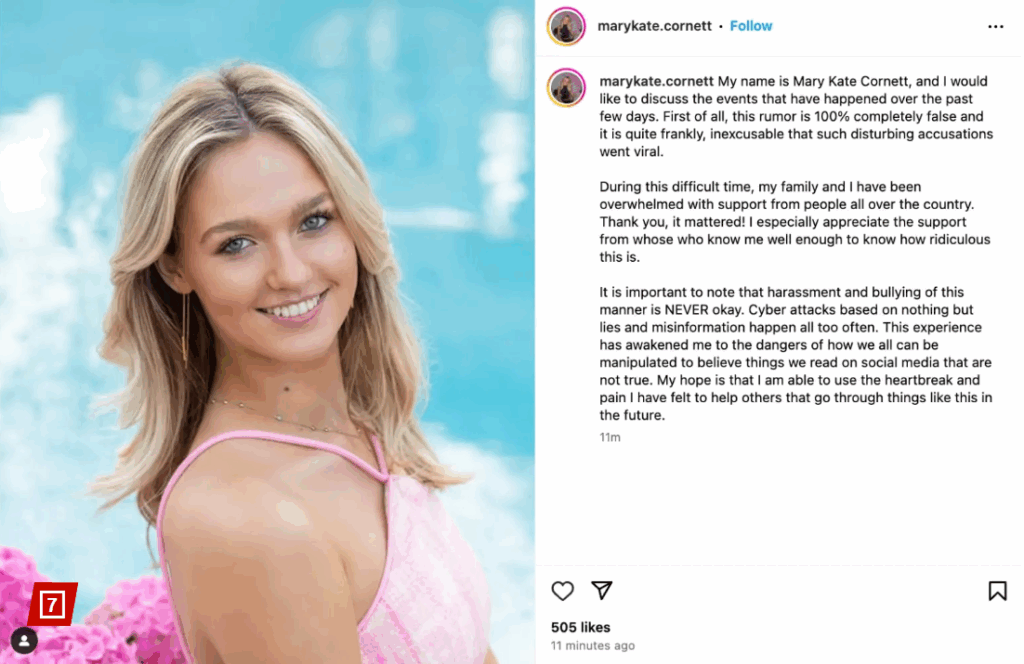
Major Media Companies Need to do Better
This sorta thing is nothing new for Barstool Sports, who are always commenting on viral trends and stories and find themselves in controversy constantly for their crude and borderline misogynistic takes. Pat McAfee, who is employed by ESPN, is not known for engaging in this type of content and it was really surprising to see an extremely popular personality of there’s acknowledge the rumor, never mind offer discourse about it. Not that ESPN hasn’t ever had a false report before, it happens to all news sites who report large quantities of news. But to be entertaining a rumor that has nothing to do with your core of being a predominately sports news outlet is pretty reckless. These companies have to have better self awareness as to the size of their audiences and the ramifications their content has. I understand that both Barstool Sports and Pat McAfee are more for entertainment of their audiences than actual news reporting, but as we saw with Mary Kate, the things they choose to talk about get a lot of attention. That requires them to be more careful about what they choose to make/create content about. In this case they took an online rumor, gave it millions of eyes, and caused an innocent girl unwarranted personal attacks, emotional distress, and probably life long trauma from the incident. There is a fine line between entertainment and unethical journalism. Yes, to a degree you have to find topics and stories that you think your audience will find interesting and engaging but at the same time, you can’t overlook the impact you are going to have on the individual/individuals that are at the center of the topic. Especially when it comes to online rumors with as sensitive of a topic as Mary Kate’s. For no reason other than million’s of peoples entertainment her name and character were dragged through the mud and it was in large part due to the roles major media outlets and personalities played in distributing the rumor to their large audiences. It is something that no apology can fix and because of Barstool Sports and ESPN, a 19 year old girls life will never be the same.
The Ethics of Athlete Privacy vs. Public Interest
Written by: Richard DiMarzo
In today’s 24/7 media world, professional athletes are no longer just sports figures. These athletes have become celebrities, influencers and public brands. This brings the question, where should the line be drawn between public interest and personal privacy? The tension between these two concepts now presents a difficult ethical dilemma for journalists, fans, and sports organizations.

Avery Bradley comforting Isaiah Thomas after tragic news of his sister passing away in 2015. (Photo from Business Insider).
During the NBA playoffs in 2017, you can see Isaiah Thomas being recorded as he has a very emotional moment with his teammate Avery Bradley. Thomas, who was the engine for the Boston Celtics in 2017, tragically received news of his sister passing away in a car accident the day before one of the biggest games of his career. Now as he struggled and was taken in by teammates, you can still see the media made sure to record him and get their story in as soon as possible.
The Blurred Line Between Private Life and Public Persona
Athletes often operate in highly visible roles, and many willingly share parts of their lives on social media or through brand partnerships. But does public status eliminate the right to privacy?
Ethics scholars argue no. According to the Society of Professional Journalists’ Code of Ethics, journalists should “balance the public’s need for information against potential harm or discomfort” and show compassion “for those who may be affected by news coverage” (SPJ Code of Ethics, 2014).
For example, Naomi Osaka’s decision to withdraw from the 2021 French Open due to mental health concerns prompted a wave of media scrutiny and fan backlash. Some journalists and commentators criticized her silence while others supported her effort to manage her mental health without public explanation. (Paraphrase from Shapiro, 2021). Osaka herself said, “It’s OK to not be OK,” reminding the world that mental health is deeply personal. Even for public figures (Time Magazine, 2021).
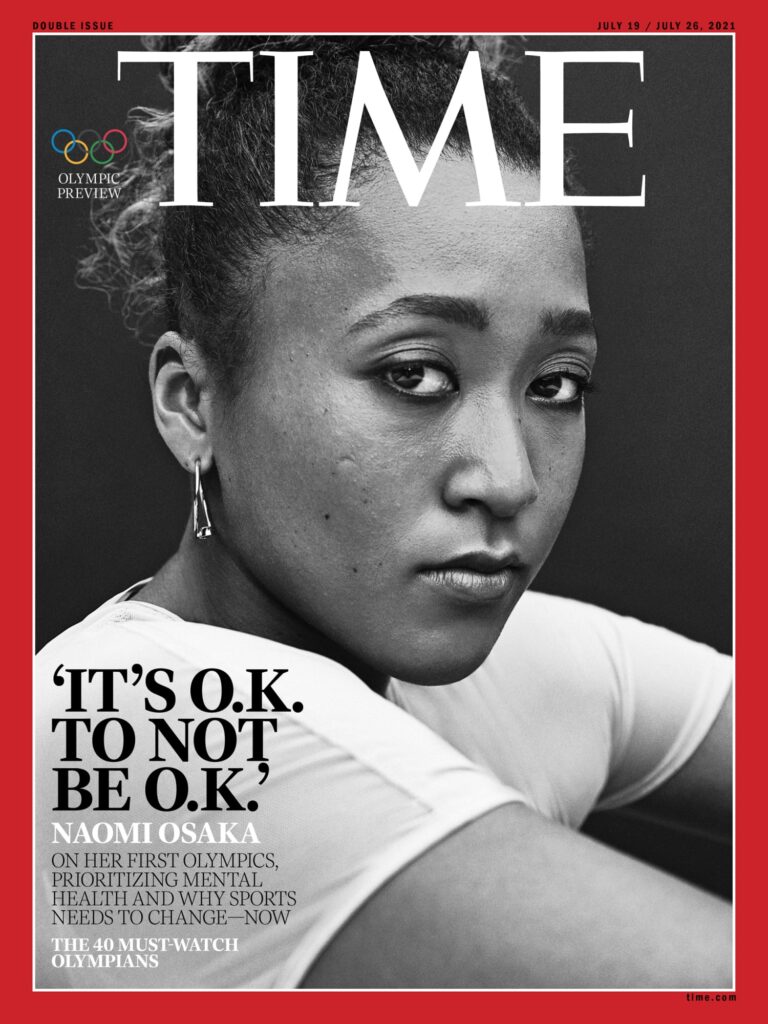
Naomi Osaka on the cover of TIME magazine, using her platform to speak out about mental health and the pressures faced by athletes in the public eye. (Time Magazine, 2021).
When Is Coverage in the Public Interest
Journalists often justify invasive coverage by citing “the public’s right to know.” But not everything the public wants to know is necessarily in the public interest.
Take the case of Tiger Woods. In 2009, his personal scandal involving infidelity was shown across headlines globally. Media outlets justified their coverage by linking his image to his sponsorships and moral branding. Despite strong efforts, critics still questioned if this was too much and over the line (Zakarin, 2020).
Ethically, journalists must look at the relevance of a private issue to a subject’s public role. If an athlete’s personal choices directly impact their performance, health, or team dynamics, coverage may be justified. But if not, the line into exploitation becomes a lot more clear.
Social Media and Consent
Nowadays, athletes often share personal updates directly with fans. This creates a unique situation where content is voluntarily public but still deserves some type of ethical consideration in how it’s interpreted.
A viral example, gymnast Simone Biles sharing her withdrawal from Olympic events due to a dangerous mental block that could potentially cause injury. Her transparency created global conversation, but brought in lots of criticism. Reporters who reused her personal posts in articles had to navigate the question of implied consent. Just because something is shared on social media, does not mean it can not be used without ethical judgement (Maine, 2021).
Conclusion
Wrapping this post up, it is clear that athletes are being invaded of their privacy daily and it is something that should be talked about more. Efforts to bring more of a clear ethical rule book has had some success, but we are definitely still not where we need to be.
Sources
Image 1: https://www.businessinsider.com/isaiah-thomas-playoffs-sister-death-ovation-celtics-2017-4
Image 2: https://time.com/6077128/naomi-osaka-essay-tokyo-olympics/
“Chyna Thomas, Sister of Celtics’ Isaiah Thomas, Dies in Car Crash.” ESPN, ESPN Internet Ventures, 15 Apr. 2017, www.espn.com/nba/story/_/id/19167406/isaiah-thomas-sister-chyna-thomas-killed-one-car-accident
“SPJ’s Code of Ethics.” Society of Professional Journalists, Society of Professional Journalists Society of Professional Journalists Improving and protecting journalism since 1909, 2014, www.spj.org/spj-code-of-ethics/
Osaka, Naomi. “Naomi Osaka: ‘It’s O.K. Not to Be O.K.’” Time, Time, 8 July 2021, time.com/6077128/naomi-osaka-essay-tokyo-olympics/
Zakarin, Jordan. Tiger Woods’ Sex Scandal: Inside His Fall from Grace and Comeback, 1 Dec. 2020, www.biography.com/athletes/tiger-woods-sex-scandal-facts
Shapiro, Michael. “Naomi Osaka Briefly Exits Press Conference in Tears after Reporter’s Question.” Sports Illustrated, Sports Illustrated, 17 Aug. 2021, https://www.si.com/tennis/2021/08/17/naomi-osaka-leaves-press-conference-tears-reporter-question
Maine, D’Arcy. “Simone Biles Withdraws from Individual All-around Gymnastics Competition at Tokyo Olympics to Focus on Mental Well-Being.” ESPN, ESPN Internet Ventures, 28 July 2021, www.espn.com/olympics/gymnastics/story/_/id/31902290/simone-biles-withdraws-individual-all-competition-tokyo-olympics-focus-mental-health
Social Media and Money Have Forever Changed College Athletics
Written by Reilly Murphy
Sports Culture
The culture of sports as we know it, has a much different meaning now than it once did even ten years ago. Gone are the days where kids were sitting on the couch watching Sportscenter each morning, and now we live in an era of scrolling through our favorite social media platforms.
With the power of social media, fans have access to both professional and student-athletes like never before. In a study conducted by the NCAA, one of every three student-athletes, during the men’s and women’s 2024 March Madness tournaments, experienced some kind of abuse on social media as a result of sports betting. By the end of the tournaments over 80% of players were involved (NCAA Media Center, 2024).
Youth in the Spotlight
In class, we’ve discussed the ethics behind young children being exposed on social media. While young adults, major companies are reaching out to athletes who have little experience of being in the spotlight.
In order to ensure good mental health and safety habits, student-athletes should be required to take an education course prior to signing endorsement deals. These should be provided by the university in order to teach healthy social media practices and handling harassment.
Betting Ethically
Since May 14, 2018, sports betting became legal in the United States (Purdum, 2018). College sports events have been centerpieces of the betting industry. Most recently, more than $3 billion in bets were placed during the 2025 men’s and women’s NCAA March Madness tournaments (Yang et al, 2025). With big money on the line of fans watching, came tremendous pressure for those in the Big Dance.
Amongst the teams featured in the 2025 March Madness tournament, was St. John’s. Led by their star player RJ Lewis Jr., the Red Storm clinched the number-two seed in the tournament following their Big East Championship victory.
A devastated RJ Lewis Jr. (middle), sits on the bench following being benched during the Round of 32. Credit: Charles Wenzelberg/New York Post
However for Lewis and St. John’s teammates, the Red Storm’s run at a national championship was cut short with a loss in the Round of 32. The gut wrenching loss, Lewis Jr. was met with an overwhelming amount of harassment from angry fans and bettors. Taking action, Lewis deleted instagram.
Sports fans are known to be passionate and show their emotions for their professional teams, but even more so at the collegiate level. The model followed by collegiate and professional athletics are becoming very similar. Should college athletes be held to the similar playing standards as their counterparts?
While collegiate athletes are earning money, the age difference of these athletes is much younger than professional athletes. These are young adults who are still working towards their degree in addition to playing their sport. It becomes unfair that people are able to place bets and add additional stress while they are still maturing as humans. In order to prevent this, betting on college athletics should be illegal.
Fan vs. Obsession
The landscape continued to shape itself in July 2021, with student-athletes being allowed to profit off their Name, Image and Likeness (NIL). This has led to collegiate athletes to become household names on the athletic playing surface, and through mainstream media (NCAA, 2025).
Livvy Dunne, looks off into the distance prior to competition in Utah.Credit: Alex Goodlet /Getty Images
There has since been an emergence of women in college sports becoming recognizable faces. Women’s basketball stars Paige Bueckers and Caitlin, and gymnast Olivia Dunne have voiced publicly their concerns of being harassed. Dunne, now a graduate of Louisiana State University, recently took TikTok of recent harassment at airports across the country.
With access to various social media platforms, student-athletes are becoming more vulnerable to harassment. Despite this occurrence, young athletes continue to push content to make an extra dollar. While some would argue that kids are at fault, billion dollar companies are offering massive deals to these student-athletes for them to profit from.
Conclusion
The landscape of collegiate athletes has moved on from how we once knew it. Gone are the days of amateurism, and the era student-athletes being able to make a penny have arrived. While the “Don’t Be a Loser,” campaign is a good start, the NCAA should consider additional resources and changes to protect student-athletes.
In order to ensure the safety of student-athletes, the NCAA should require NIL informational courses and guidance prior to working with companies. Additionally, sports betting on collegiate athletic events should be considered illegal. Big name companies should also consider the ethical responsibilities of working student-athletes.
“TikTok Made Me Buy It”: Where’s the Line Between Genuine Love and Paid Hype?
Written by Colby Paolo
If you’ve ever scrolled through TikTok and ended up impulse buying a lip gloss, a pair of Amazon leggings, or a facial ice roller, you’ve probably fallen for the power of influencer marketing, sometimes without even realizing it. The phrase “TikTok made me buy it” has become a cultural phenomenon, with creators across platforms casually recommending products that often turn out to be tied to affiliate links or paid brand partnerships.
As someone who both consumes and creates content, I’ve started thinking more critically about where the line exists between honest opinions and subtle advertising. Are creators truly obsessed with these products, or are they just chasing commission checks? More importantly, what do they owe their audience in terms of transparency?
What’s the Ethical Issue Here?
At its core, this is a question of media ethics: When influencers blur the line between personal recommendation and advertisement, they risk misleading their followers, especially if they aren’t disclosing that they’re being paid to post.
The Federal Trade Commission (FTC) actually has guidelines in place requiring creators to disclose sponsored content or affiliate relationships. But on platforms like TikTok, the pace is fast and the captions are short, and those disclosures are brief or even left out completely.
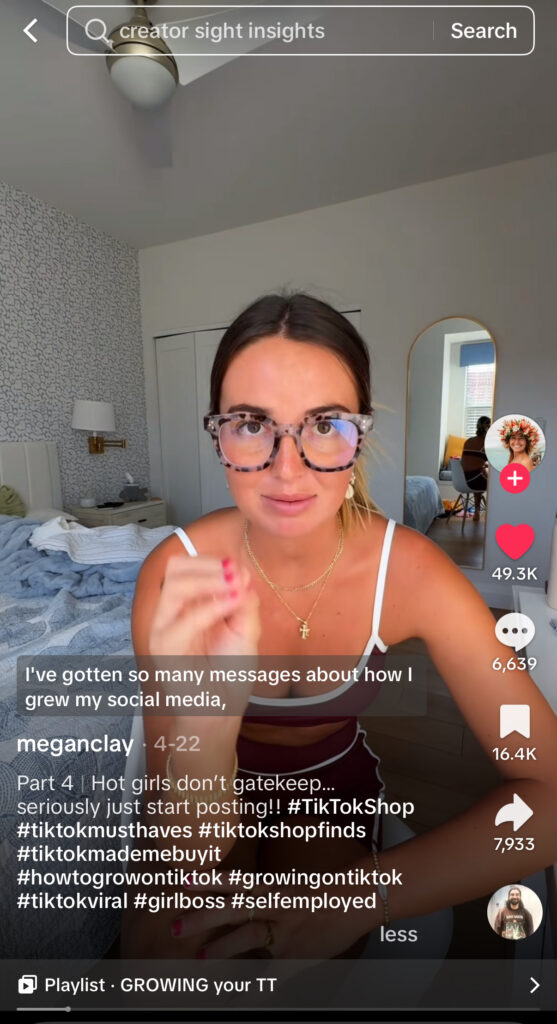
This raises a huge ethical red flag. According to the principle of telling the truth in media ethics, audiences have the right to know when a piece of content is designed to persuade or sell. And when that’s not obvious, creators risk breaking the trust they’ve built with their followers.
Photo Credits: @meganclay on TikTok
Why Does This Matter?
The influencer and follower relationship is built on loyalty and trust. Many people follow creators because they believe in their taste, their values, or their aesthetic. But when money is involved behind the scenes, those recommendations can become less about helping viewers and more about making a profit.
It’s not inherently unethical to earn money from brand deals or affiliate links. In fact, for many creators, that’s how they make a living. The issue is the lack of transparency. Audiences deserve to know when a product is being promoted because of a financial incentive.
This becomes even more important when you consider younger audiences. Many TikTok users are teenagers or young adults who may not recognize the difference between an organic recommendation and a strategic marketing tactic. Creators have a responsibility not to take advantage of that blurred understanding.
Photo Credits: Anya on TikTok

Applying Ethical Principles
Using Sissela Bok’s Test of Publicity, we can ask: Would a creator feel comfortable if their audience knew the full financial arrangement behind a “TikTok made me buy it” post? Would the audience still feel the same way about the product or even the creator if they knew the post was sponsored?
If the answer is no, that’s a sign that the content lacks ethical transparency.
What Should Creators Do?
Being ethical doesn’t mean creators can’t monetize their content. But it does mean:
- Clearly labeling sponsored content and affiliate links (in the first few seconds or lines, not hidden in the hashtags)
- Only promoting products they truly believe in or have tested
- Being upfront with followers about when a post is part of a brand partnership
At the same time, platforms like TikTok should also take more responsibility by making disclosure options more user friendly and harder to bypass. Right now, it’s too easy to let things slide under the radar and when that happens, it’s the audience that ends up misled.
Link to TikTok Example
Video Credits to @elmzaplays on TikTok
Final Thoughts
As influencer marketing becomes more normalized, we all have a role to play in keeping the space ethical whether we’re creators or consumers. When someone says “TikTok made me buy it,” the goal should be enthusiasm and not deception.
Honesty builds trust. And in a digital world full of sponsored posts and hidden links, that trust is more valuable than any commission.
Citations
Federal Trade Commission (FTC). “Disclosures 101 for Social Media Influencers.” https://www.ftc.gov/business-guidance/resources/disclosures-101-social-media-influencers
Wilkins, Lee, et al. Media Ethics: Issues and Cases. Rowman & Littlefield, an Imprint of The Rowman & Littlefield Publishing Group, Inc, 2022.
Bok, Sissela. Lying: Moral Choice in Public and Private Life.
Fortnite Brings Darth Vader to Life with AI — and It’s Just the Beginning
By Jacob Flynn • Published June 2025
In May 2025, Epic Games launched one of the most ambitious artificial intelligence projects in the gaming world when players would not only be able to fight Darth Vader in Fortnite, but for the first time ever, speak to the Sith Lord—and have him respond.
Darth Vader’s voice, represented by James Earl Jones, was artificially recreated to such an extent that nostalgia, progression, and ethical implications of how far entertainment can go and should go became blurred.

However, is something like this even okay? Should a deceased man’s voice be allowed to be used even if he gave permission? Is it even okay for the human element of acting be taken away?
The Technology Behind Vader’s Voice
But how did this happen?
Epic Games solicited the assistance of several top AI companies to make this a reality.
The goal was to create an in-game version of Darth Vader that could not only be the character and let people fight against him, but also talk to him, in real time.
With a voice so seamless, players would not know whether they were talking to a digital version of James Earl Jones or a real person.

A Voice with Permission
However, like many projects created with AI involvement, this was not done without permission or behind hidden doors. James Earl Jones officially exited from voicing Darth Vader in 2022 and relinquished rights for Lucasfilm to use his vocal image. Thus, this venture ensured that the AI vocal work remained true to his initial performance.
Controversies and AI Misuse
However, the addition was met with controversy shortly after launching. Players began testing the limits of AI, trying to get Vader to say inappropriate and disgusting things. This forced Epic Games to establish filters and restrict replies to avoid such trickery.
This renewed debates between voice actors as well. The use of AI to mimic performances, even when done legally and with consent, has drawn concerns from some actors and unions, such as SAG-AFTRA.
A lot of people are worried about the long-term effects of using artificial actors in place of real ones.
Disney has had a history of bringing back actors using AI and CGI, whether that be back from the dead or de-aging them. It most commonly occurring within the Star Wars franchise.
They’ve done it in the popular Disney+ series, “The Mandalorian ,” and it’s own spin off show “The Book of Boba Fett.”
Both shows feature a younger version of Mark Hamil’s character Luke Skywalker, using a combination of computer graphics, a body double, and an AI voice to recreate how Hamil sounded when he was younger.
What This Means for Media
AI capabilities have far-reaching effects that extend beyond this particular Fortnite event.
In our future, non-player characters (NPCs) in video games could be able to recall your previous actions, have meaningful conversations, and speak in full voice — all without requiring a human actor to record each interaction.
This experiment may lead to the development of AI-powered, enduring characters in popular franchises, especially in Epic’s developing metaverse concept. This kind of AI provides a degree of interaction that was previously only possible in terms of immersion and personalization.
Fans recognize this technological advancement, but there are still many unresolved issues. When actors’ voices are reused by AI, how should they be paid? Is it vital for studios to reveal when a voice is artificial? And how can we guarantee responsible use of this technology?
Actors are the core of these stories; they take what is put on the page and bring it to life. Without someone like James Earl Jones, there is no Darth Vader, and without Mark Hamill, there is no Luke Skywalker.
AI takes away not that human element of stories but takes away jobs and opportunities from people everywhere.
Exposing Childhood: The Ethics Behind Family Vlogging
Jenna Peccia
According to The Washington Post, the 8 Passengers Youtube channel had more than 2.5 million subscribers at its peak, with daily vlogs documenting the life of mom, Ruby Franke and her six children. For many years, the family shared personal moments, including emotional punishments and strict parenting, all under the watch of eyes of millions of viewers. In August 2023, Ruby Franke was arrested on multiple felonies of child abuse charges after one of her children escaped and found help. Jodi’s business partner, Jodi Hildenbrant, was also taken into custody during this time. The case sparked widespread backlash and raised serious concerns about the lack of legal protection for children featured in monetized family content.

A look at 8 Passengers Youtube Channel (Photo from The Catalyst)
Before its shutdown, 8 Passengers was one of the most watched family vlog channels on Youtube, highlighting the fine line between documenting childhood and exploiting it for views.
The 8 Passengers case swept the nation during the summer of 2023. The hashtag #8Passengers is tagged on about 34.9k TikTok posts and has generated millions of views. Hulu presented a documentary called Devil in the Family: The fall of Ruby Franke, which explores the case in-depth.
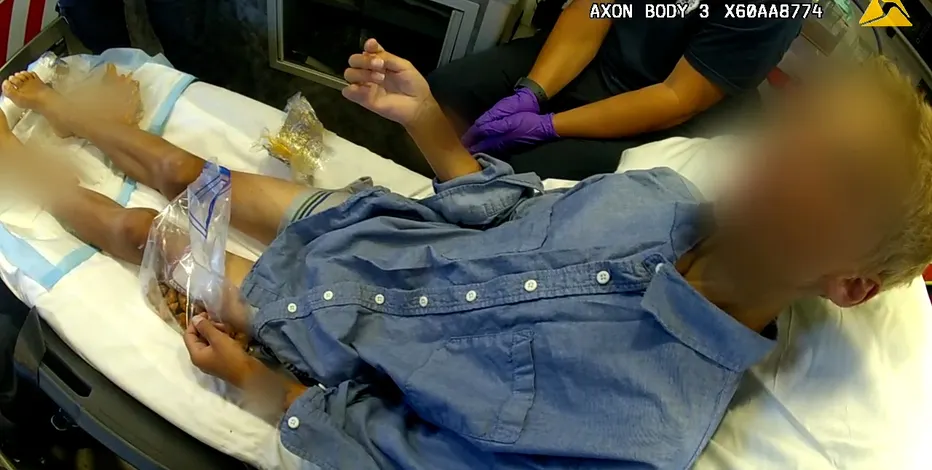
Ruby Franke’s son in an ambulance after escaping (Photo from FOX9)
While looking at Ruby Franke’s case and the thousands of other cases throughout the United States, why are only popular social media influencers getting media coverage and documentaries to share their stories? Is it due to their popularity or was it just a very specific case that caught the eye of news reporters?
According to NBC News, although the Franke’s are not A-list celebrities, the case became popular when her followers became curious to witness the downfall of their once favorite Youtube star.
Shouldn’t there be laws in order to protect these children?
According to AP News, Utah added protection for Child Influencers following Franke’s child abuse conviction. The law now states that online creators who make over $150,000 per year from content featuring their children, will be required to set aside 15% of that into a trust fund in order for the kids to access it when they turn 18.
Additionally, Desert News reports that once children turn 18 years old they now have the right to request deletion of their content. This is a significant step forward giving them control over their digital footprint.
Is the Franke family the only family to experience child abuse?
Unfortunately no, Komo News shared a troubling rise in child tourture cases in Utah. According to the CDC, 1,820 children have died from child abuse and neglect nationwide in the year 2021. In 2022, a disturbing trend that highlights a broader issue far beyond influencer fame.
The National Library of Medicine shared a study that shows the Impact of News Media on Child Abuse Reporting. The results shared that child abuse cases reports as well as news coverage increased. Yet, rather than the media stories increasing mandated reports therefore showing a rise in reported cases.
How can we better share these stories on social media and in the news?
The media has faced growing criticism over how it covers child abuse- especially when it happens behind the camera of a “family-friendly” Youtube channel. In cases like 8 Passengers, where there were warning signs for years. Viewers watched Ruby Franke discipline her children harshly on camera, but many dismissed it as strict parenting or even entertainment.
Imagine if the red flags had been treated as real concerns earlier on. Greater media attention, critical reporting, and accountability from social media platforms like Youtube could have let to earlier intervention. These children may have been protected sooner.
Abuse doesn’t stop being abuse just because it’s happening in front of a ring light.
Navigating Digital Accountability: Jenna Marbles and Cancel Culture
Written By: Katie Cappello
On June 25th, 2020 one of YouTube’s most beloved creators posted her final video to the platform. There was no dramatic scandal. No sponsors pulling out. No algorithmic exile. She left of her own volition after addressing past videos that included racial stereotyping and insensitive humor. Her departure sparked a large debate over cancel culture, media ethics, and its influence in the digital age.
But what does it mean to be canceled, and was Jenna Marbles truly canceled?
According to Pew Research, Cancel Culture can have many different definitions depending on who you ask, but according to their research, one response stood out the most. That response involved accountability. One response that aligns with this situation reads: “Cancel culture is a movement to remove celebrity status or esteem from a person, place, or thing based on offensive behavior or transgression.” Being canceled can be a way for the accuser to show accountability and forgiveness, but also lead to loss of reputation, career opportunities, or an online platform.
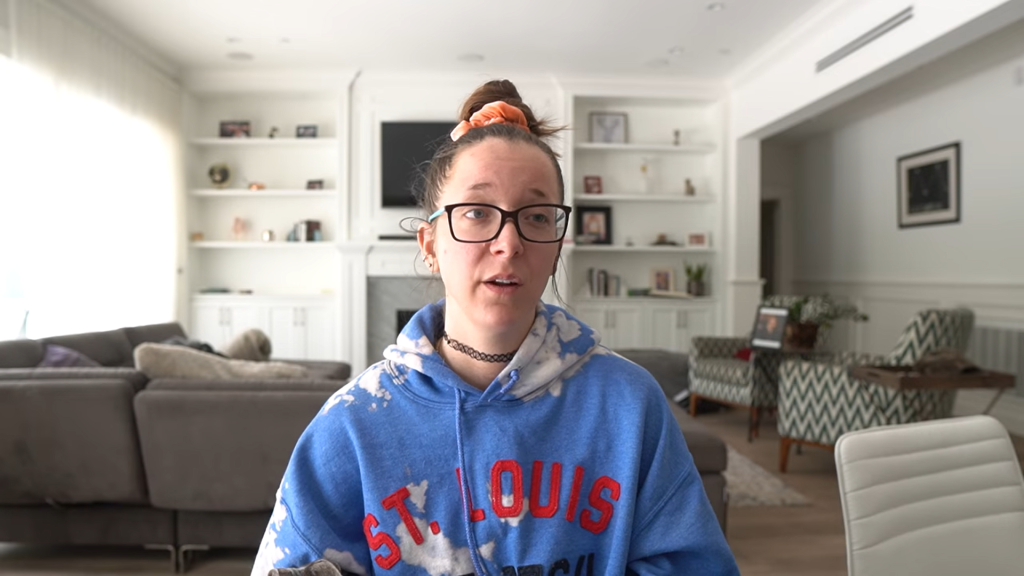
Critics argue that cancel culture encourages groupthink and punishment and withholds free speech. On the other hand, supporters see it as a tool for social accountability, especially in industries where traditional structures fail to deliver fair consequences.
Jenna Mourey, known online as Jenna Marbles, is a rare example in the cancel culture conversation. She wasn’t pushed out by others — instead, she took responsibility for her actions, apologized, and chose to leave on her own.
In Marble’s last video, titled “A Message”, Jenna emotionally addresses her past controversial content. She apologized for several videos she made in the early 2000s including her wearing dark makeup (often referred to as blackface, a racist form of theatrical makeup) and making rude and hurtful comments about people of Asian descent.
When it comes to accountability vs cancelation, Jenna models accountability. According to the Join Our America organization, holding people accountable for their actions means their punishment should be tied to the action they took. Jenna modeled accountability. She identified her mistakes, acknowledged them publicly, and took deliberate action to repair the harm. She left the platform where she became known and loved as a creator.
Her choice to leave YouTube is tied to the mistakes she made in the past, posting racially insensitive videos on the platform. Jenna stepped away from not only making content but also her main source of income, showing how serious she is about taking accountability for her past actions.
When relating her decision to an ethical principle, I would say she relates most to Confucius’s Self-Cultivation principle. She is doing what needs to be done to refine herself and her morals. This action of self-reflection is not only benefiting her but also the public. She’s showing that it’s okay to pause, reflect on your mistakes, and use them as a chance to grow.

This case still raises several ethical questions for content creators:
- Should creators be held to modern standards for content made in the past?
- Does a sincere apology entitle someone to continued fame?
- What responsibilities do influencers have to their audiences?
With over 19.5 million subscribers at her peak, Jenna understood that media reach carries ethical weight. As an internet figure, viewers form one-sided relationships with creators — her behavior had a real influence on her fans’ views and values.
Since Jenna Marbles left the internet, she has stayed almost completely offline. She hasn’t come back to YouTube or social media, even though many fans have asked her to. Her silence says a lot. In a world where many influencers quickly return with a new image, Jenna’s choice to stay away shows a rare kind of true responsibility; quiet, honest, and not for show.
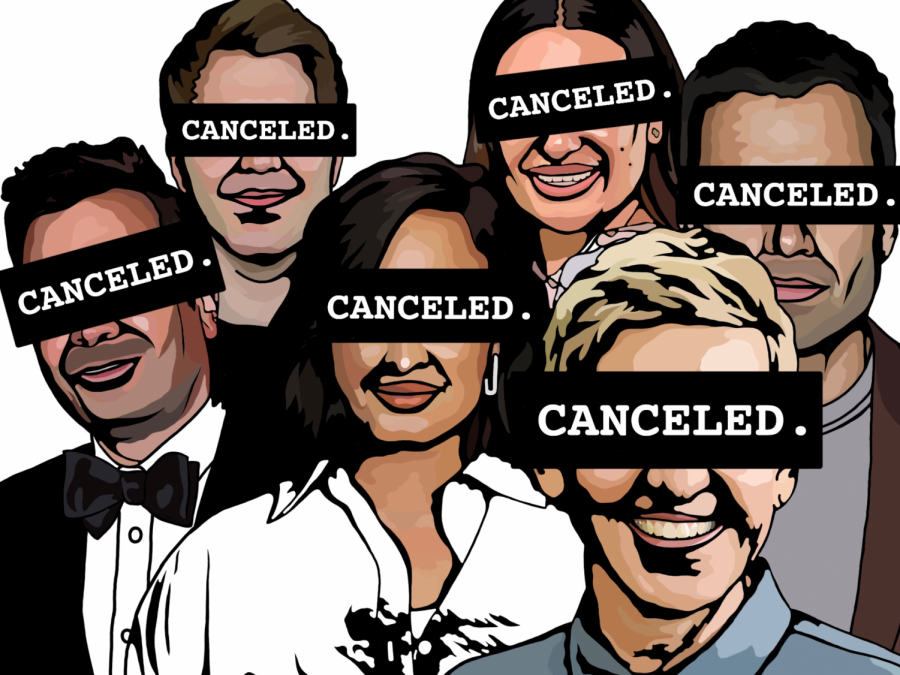
Some might ask: does someone need to leave public life to show true accountability? For some, disappearing might seem like avoiding public criticism. But in Jenna’s case, it came across as a humble and sincere choice. She didn’t try to control the narrative or strive for recognition. She didn’t use her apology to rebuild her brand. She simply meant it — and stepped back.
Jenna Marbles didn’t wait to be canceled by the public. She canceled herself, not out of fear, but out of an ethical imperative to do better to make space for others to grow without her shadow. As the conversation around cancel culture continues, Jenna’s story reminds us that accountability is not the end of a brand but it might be the beginning of a more honest one.
Can you come back after being cancelled? Let’s talk about it.
What is Cancel Culture?
Cancel culture is the online practice of shaming and boycotting individuals in the spotlight for behavior deemed offensive or problematic. This usually plays out on social media and everyday users “call out” the public figures and demand consequences. These consequences usually include lost brand deals, losing followers, and demand for accountability.
Cancel culture thrives in digital spaces where virality accelerates judgement. While it may appear democratic, fame and wealth often influence whether someone is canceled or simply criticized.
Accountability vs. Public Shaming
Clark (2019) argues that cancel culture often reflects a mix of social justice and spectacle, where news outlets amplify outrage to feed public demand for punishment. Are we seeking accountability or simply inflicting punishment for entertainment? News platforms often push the cancellation by reporting on the outrage viewed on social media.
The Social Responsibility theory states that the media has freedom of expression but should act ethically and factually. Sometimes there is a genuine need for a celebrity to be held accountable for their actions while other times it is simply performative for clicks and likes.
Screenshot from James Charles apology video Credit: James Charles YouTube
James Charles: A Case Study in Misconduct and Public Response
In April 2019, beauty influencer James Charles got into a very public feud with fellow beauty influencer Tati Westbrook who accused him of being manipulative of younger fans. The allegations got very serious in early 2021 when inappropriate messages were released. These messages included Charles allegedly pressuring minors into flirtatious exchanges, despite their age being known or discoverable.
The fallout from this involved him losing over 3 million subscribers in less than a week and losing even more after the newer accusations came out. According to Insider (Tenbarge, 2021), Morphe officially ended its partnership with James Charles due to consumer backlash and misconduct allegations.
Charles released several videos prior to his main apology. These earlier videos often denied the allegations and deflected responsibility. In April 2021, he released a formal YouTube apology titled “Holding myself accountable” where he admitted to his wrongdoings and promised to change. He expressed his intent to change by stepping away from dating apps, rethinking how he communicates with fans, and committing to personal growth. Many criticized the apology as performative and incomplete.
Now the question is, was this feud just for the clicks or to hold Charles accountable for his statements and actions?
Redemption and Growth
Ethical questions arise when we consider the difference between accountability and public shaming. James Charles admitted fault and corrected actions followed these patterns. But once audience trust is broken, it is hard to regain because they feel their relationship has been betrayed.
Permanently labeling someone for their past offenses might contradict the goal in restoring justice principles. Cancel culture’s downfall is that it leaves no space for forgiveness. Aja Romano (2020) argues that cancel culture surged in 2020 as people, confined to social media, used old content to call out public figures.
Jenna Marbles on the red carpet at an event for YouTubers Credit: David Livingston // Getty Images
Jenna Marbles: A Different Approach
In contrast to James Charles, Jenna Marbles showed how ethical responses can resonate with fans. In 2020, videos resurfaced of Marbles from 2012 containing racial stereotypes and blackface. Instead of denying or downplaying the allegations, she quickly issued a sincere and quite emotional apology and voluntarily left YouTube at the same time.
Marbles didn’t use the scandal to profit or redirect attention. She removed videos and distanced herself from her online platforms. Despite not being back on YouTube, she has maintained respect in the creator community. This worked in her favor, because she released a very transparent apology while also stepping away voluntarily. She didn’t make any money from the scandal like other creators and retained goodwill with her loyal audiences. Cancel culture tends to enforce the belief that certain actions permanently define one’s character, regardless of growth or context.
Her case illustrates that when someone acknowledges their harm and follows it with meaningful, self-imposed consequences, it can create an open space for growth for themselves and their audiences.
Conclusion
Cancel culture asks us to not only consider who gets cancelled, but also who gets forgiven and why. Is it gender based, race, follower size? Society has many biases that often shape who is allowed this redemption.
If cancel culture is to become ethically sustainable, it needs to evolve. It should distinguish itself between harmful patterns of behavior and one-time errors. It should demand accountability without erasing the possibility of redemption. The goal shouldn’t be permanent exile, but instead informed consequences and space for repair.
Ultimately, cancel culture is not inherently unethical but how we use it and whether we allow space for learning and repair, determines its values.
Written by: Vicki Robinson
The Dunkin’ Drive Through
Alyssa Keane

Call me crazy, but for a good portion of my life my daily routine went something like this…
Wake up, place a mobile order, go to Dunkin’, get a “sweet treat”, Repeat.
Some may even call me insane — and they’d be right. Insanity, by definition, is doing the same thing over and over again expecting a different result. I unfortunately can’t help myself.
Dunkin’ holds a special place in my heart. This place is sacred to me and my mom… even if she doesn’t know it.
I was introduced to the joys of a tasty iced coffee at the ripe age of I don’t even know when! However, if we look back, my addiction to my local Dunkin’ drive through isn’t new to my coffee era.
Hitting the Dunkin’ drive throughs on hot summer afternoons with my mother seems to be where this ritual formed in my brain as a necessary daily activity. To me, it was more than a pitstop on our route home.
Sitting in the Dunkin’ drive through was a bonding experience. Something that tied me and her together. Something so small and so miniscule most would fail to notice. It was our time away from the rest of the world to catch up on the latest drama.
I didn’t always order an over-caffeinated beverage. My favorite drink as a kid was the infamous coolatta. Now I know what you’re probably thinking; I can still have a coolatta! Kept my loyalties to a beverage where the caffeine didn’t feed my jitterbugs. No one was forcing me to drink an iced coffee, but let’s be realistic. There may be no age limit on the Dunkin’ Coolatta, but if I were to guess the fine print probably reads “for kids ages 5 through 12.”
Dunkin’ watched me evolve as I ditched the coolatas and moved on to bigger and better things… like a small iced coffee loaded with creamer, sugar, and flavored syrup.
As I got older I frequented the same drive through every day. It was different though. I now had my license and my mom was speaking from the inside of my sound system. I spent more time with my friends before school, leaving my mom and I’s special drive through time in the past.
Come senior year, my friends and I practically clinked our medium iced coffees together on our last day. One last treat before we went our separate ways.
When it was time for my next chapter I made the decision to head to Bridgewater State University. Moving away from home was intimidating and scary. I was miles away from my home, my friends, and my comfort drive through. Would it even remember me when I returned for fall break???
Scared half to death, my roommate and I timidly wandered around new and uncharted territories.
In our search for the book store we came across a Dunkin’ right on campus. Although I may have been far from home, the smell of coffee grounds, the sounds of the never ending receipts printing, and the blinding orange and pink decor made me feel right at home.
So when people ask me “what was the catalyst for my raging coffee addiction?” I tell them it must’ve happened somewhere along my college experience even though I know that deep down it started a long long time ago. A time when it was just me, my mother and a blue raspberry coolatta.
